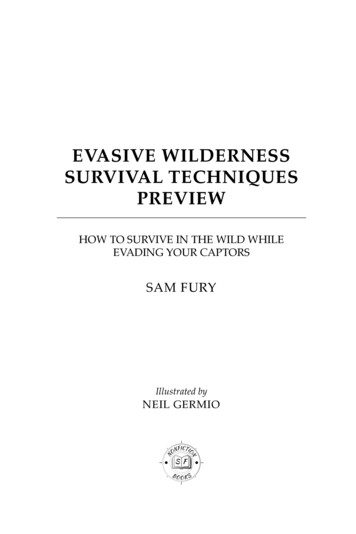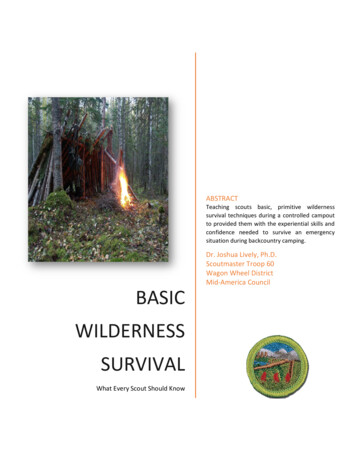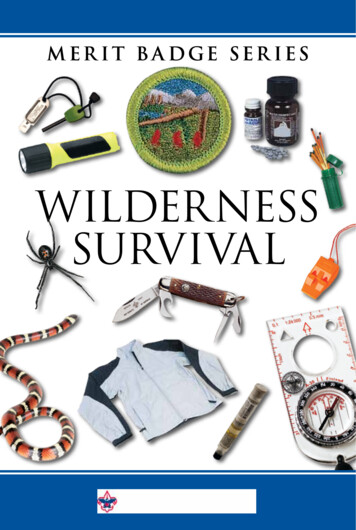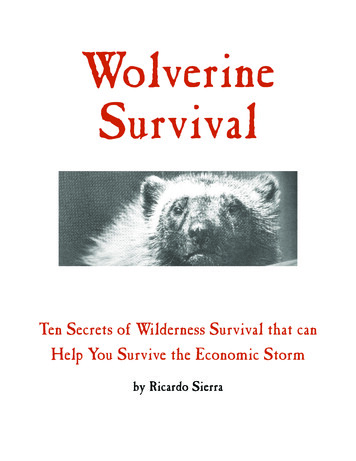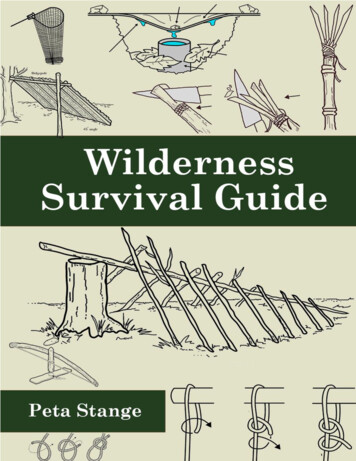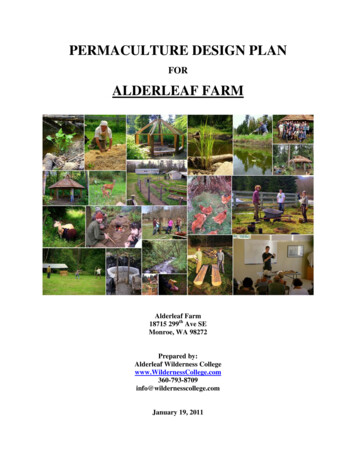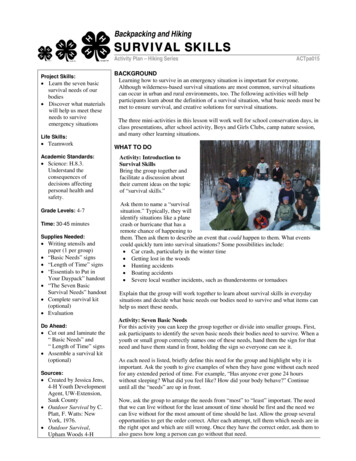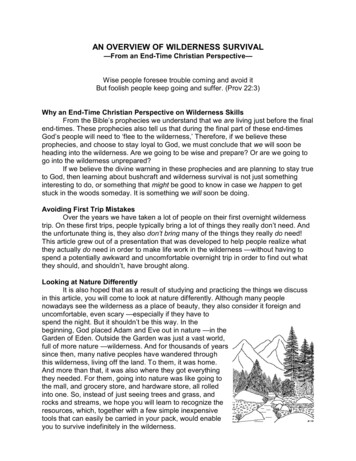
Transcription
AN OVERVIEW OF WILDERNESS SURVIVAL—From an End-Time Christian Perspective—Wise people foresee trouble coming and avoid itBut foolish people keep going and suffer. (Prov 22:3)Why an End-Time Christian Perspective on Wilderness SkillsFrom the Bible’s prophecies we understand that we are living just before the finalend-times. These prophecies also tell us that during the final part of these end-timesGod’s people will need to ‘flee to the wilderness,’ Therefore, if we believe theseprophecies, and choose to stay loyal to God, we must conclude that we will soon beheading into the wilderness. Are we going to be wise and prepare? Or are we going togo into the wilderness unprepared?If we believe the divine warning in these prophecies and are planning to stay trueto God, then learning about bushcraft and wilderness survival is not just somethinginteresting to do, or something that might be good to know in case we happen to getstuck in the woods someday. It is something we will soon be doing.Avoiding First Trip MistakesOver the years we have taken a lot of people on their first overnight wildernesstrip. On these first trips, people typically bring a lot of things they really don’t need. Andthe unfortunate thing is, they also don’t bring many of the things they really do need!This article grew out of a presentation that was developed to help people realize whatthey actually do need in order to make life work in the wilderness —without having tospend a potentially awkward and uncomfortable overnight trip in order to find out whatthey should, and shouldn’t, have brought along.Looking at Nature DifferentlyIt is also hoped that as a result of studying and practicing the things we discussin this article, you will come to look at nature differently. Although many peoplenowadays see the wilderness as a place of beauty, they also consider it foreign anduncomfortable, even scary —especially if they have tospend the night. But it shouldn’t be this way. In thebeginning, God placed Adam and Eve out in nature —in theGarden of Eden. Outside the Garden was just a vast world,full of more nature —wilderness. And for thousands of yearssince then, many native peoples have wandered throughthis wilderness, living off the land. To them, it was home.And more than that, it was also where they got everythingthey needed. For them, going into nature was like going tothe mall, and grocery store, and hardware store, all rolledinto one. So, instead of just seeing trees and grass, androcks and streams, we hope you will learn to recognize theresources, which, together with a few simple inexpensivetools that can easily be carried in your pack, would enableyou to survive indefinitely in the wilderness.
“I’ll never look at a bunch of pine needleslaying on the ground the same wayagain!” —Brian PolmWe also hope that as you experience nature, you will find it less foreign andscary, and learn that you can be relatively comfortable in it.‘Flipping Switches,’ and ‘Setting Things Out On the Craft Table’A big part of the problem is that in our modern world, many of life’s necessitiescan literally be had ‘at the flip of a switch.’ If it is too hot or too cold —just move thethermostat up or down. If we are hungry —just take some food out of the freezer, put itin the microwave, and push a few buttons. If we need a drink of water, or need to getwashed up —just turn the faucet knob. Since this has been the case f or a couplegenerations now, many people, especially children, have no idea where our necessitiesactually come from. Neither do they realize all the preparation work that has gone intobeing able to have what we need ‘at the flip of a switch.’ The worst part is that many ofus no longer even think about, or plan to have our needs met because everything hasalways ‘just been there.’Similarly, many youth organization and schools have some sort of ‘crafts’ as apart of their program. Typically, all the materials are set out on the table before thechildren even show up. So when it’s time to do ‘crafts,’ the kids just come sit down atthe table and do the craft —with no thought of all the preparation that was necessary forthem to be able to do the activity.On the other hand, in the wilderness there are no ‘switches’ or ‘buttons,’ neitheris there any ‘craft table’ that has already been set up with all the materials to do survival‘activities.’ For example: On a recent hike, a group of boys were given the task ofstarting the fire. They were all intently huddled around the fire-pit. One of them wasadding the last twig he had gathered to the flickering flame. The others just sat thereand watched as the flame burned through the few sticks they had placed on it —andthen went out. Because these boys were not used to ‘setting things out on the crafttable’ for themselves, they had failed to gather enough kindling to build up the fire.So, what do we need to ‘set out on the craft table’ so that we can survive in thewilderness? That is the topic of this article.Let’s Go On an Imaginary ‘Hike’The presentation this article grew out of consists of a ‘hike.’ But this ‘hike’ isn’tjust walking to some destination and back. Our goal here is to show, through a series ofhands-on activities and demonstrations, all that we would need to do to be able tosurvive for 24-plus hours in the wilderness. In the course of these demonstrations, theequipment that we would need in order to do these activities also becomes apparent.This, in turn shows what we would need to ‘set out on our craft table,’ or in this case,bring with us in our packs.Although we always did as many activities on these ‘hikes’ as we had time for,we were never able to do everything we would have liked to do. So a booklet was-2-
developed as a way to share that additional information, as well as being a reminder ofwhat we had done. If you would like a copy of this booklet, contact me at jabuller7@juno.com Because it will probably not be possible for you to go on one of these ‘hikes’ withus in person, let’s picture an ‘imaginary’ overnight wilderness hike here. Since we arewanting to develop our wilderness skills, we will put ourselves in ‘survival mode’ fromthe very beginning of the hike. We will also assume that we are all wearing adequateclothing for this type of excursion. To make it easier to go back and summarize, thekey equipment items that we would want to carry in our packs appear in bold print thefirst time they are mentioned.As we walk along, we notice the many different plants growing in thearea. Some of these plants have edible bulbs. So we decide to dig up some ofthese bulbs to eat with our lunch. What would we need in order to be able tocollect these bulbs? —Some digging sticks. However, we don’t have any diggingsticks with us. So we decide to stop and make a few, as they will also be usefulfor many other wilderness living tasks. In a nearby tree we find a suitablebranch. What would we need in order to cut the branch and make the diggingstick? —We could do it all with a knife, but a collapsible saw to cut the branch,and a machete or hatchet to chop off the branchlets and make a point on oneend would be nice. We’ll use the knife to peel off the bark and smooth andrefine the overall shape. All these tools will come in handy for many otherwilderness tasks as well. So we stop for a bit to make some digging sticks forour group, and then we dig up some of the edible bulbs.Since we have just started hiking, and it is not yet time for lunch, wewant to bring the bulbs along with us. But what can we use to carry them?—We could take the time to weave a basket. But if we had a bandanna orscarf, we could simply tie the bulbs up in the scarf and put them in ourpacks. Or we could tie the adjacent corners together to make a bag withhandles to carry them in.After we have hiked on a ways, we come to a creek crossing. By thistime we have gotten thirsty. There is plenty of water in the creek, but itprobably is not safe to drink straight from the stream. So what do we needin order to boil and purify some water? —A cook pot, and a fire.But what do we need in order to make the fire? —Some drysticks, which we can easily gather nearby, and some type of firestarter. We should be sure to carry some sustainable method offire-starting, such as the historic ‘flint & steel.’ Otherwise, whatwould we do after we’ve used our last match, or the lighter runsout? So we build a small fire, take our cook pots out of our packs,fill them with water from the creek, and use the digging stick to put the pots full of wateron to boil. After the fire brings the water to a boil, we take the pots out of the fire and letthe water cool so we can drink it.-3-
In order to take some water with us as we continued hiking, what would weneed? —We could carry it in the cook pots, but some simple water bottles would workmuch better.While we are waiting for the water to boil and then cool, we realize it is abouttime for lunch anyway. So since we already have a fire going, we decide to cook theedible bulbs we gathered. We untie the scarf and use it as a ‘table cloth’ to provide aclean work area for food preparation. What are we going to need to cook these bulbs?—Again, the cook pot and the fire. So we get a pot of the edible bulbs cooking.What else would we need to cook and eat our food? —Some sort of‘utensil.’ We could easily make some chop-sticks, or simply flatten a stick tomake a sort of spatula. But what would we need in order to make thesesimple utensils? —Again, the saw to cut the sticks, and a knife to refine theshape.After we have eaten our lunch, we wash our ‘dishes,’ and thenpeel and smash one end of a willow twig against a rock with our diggingstick to make toothbrush to brush our teeth. Then, we continue hiking,interacting with nature along the way and gathering more wild ediblesthat we find.Later that afternoon, we find a nice place and decide to make our camp. Wecould make shelters entirely from natural materials, but it would take a lot ofmaterials to shelter our group. So what could we have easily brought with us tomake a shelter with? —A tarp and some twine. But we’ll also need some poles tomake a frame for the tarps. What would we need to cut and clean, some standingdead poles? —Again the collapsible sawand a machete or small axe. So we gather somepoles, and set up some tarp shelters for ourgroup. We also gather debris, (pine needles,leaves, moss, grass, etc.), to make debris bedsinside the shelters. But what else would we needin order to comfortably spend the night? —Sometype of bedding, like blankets or sleeping bags.So after we get our shelters and bedding all setup, we make another fire, and cook somesupper. After spending a pleasant eveningaround the campfire, we bed down for the night.In the morning we wash up in the creek, build the fire back up, and make somebreakfast. After washing our ‘dishes’ and brushing our teeth, we take down our camp,re-scatter the debris, and head down the trail for another day.So, what were all the equipment items that we would have needed to bring withus in order to do all of the things we needed to do during this ‘imaginary’ 24 hours in thewilderness? Please note here that if we are equipped to spend ‘24 hours’ in thewilderness, we will also have what we would need to be able to stay longer. We wouldjust have to replenish our supplies of water, firewood, food, and certain hygiene itemsfrom nature.-4-
Basic Wilderness Living EquipmentG Adequate ClothingG Bandana / ScarfG BeddingG TarpG Water BottleG Fire-StarterG Cook PotG Knife (this would also include the small axe or hatchet, the bush knife ormachete, and the folding saw, as well as sharpening stones and/or files tokeep them sharp)G Cordage (Twine)G Pack (to carry it all in)Studying wilderness survivalteaches you how few items reallyare essential, and how essentialthose few items really are.SURVIVAL PRIORITIESThe Survival Priorities are the things that we need, (not counting Air), in order tostay alive, wherever we might be. All the items we used in the ‘hike’ mentioned earlierare based on these priorities. I would definitely be worth memorizing this list.Shelter is first, because within a few hours we will most likely need shelter fromsomething. Water is second, because under most conditions we could make it into thenext day without water. Food is last, because we could survive a couple weeks withoutfood —we may not feel very good about it, but we’ll live. Health Concerns representsthings like safety, sanitation and hygiene, and getting adequate rest. It is in the middlebecause we always want to stay safe and healthy. Even under ‘normal’ circumstances,if we were to get sick or injured it would make our situation worse, and we definitelywouldn’t want something like that to happen in a survival situation. Fire is also in themiddle, as it may be needed in connection with our Shelter for warmth and light, topurify Water by boiling it, and for cooking Food.-5-
The order of these priorities is especially important at the beginning of a survivalsituation. There is simply so much that needs to be done, and usually there is a limitedamount of daylight to do things. So we simply must do first things first, and not wastetime on non-essentials.Survival Priority EquipmentBased on the Survival Priorities, there is an expanded list of actual equipmentitem categories which we need in order to provide ourselves with these priorities. Wewill call this expanded list ‘Survival Priority Equipment.’ ‘Tools’ have also been includedhere, because although they are not a direct need, they enable us to get the things wedo need more easily and efficiently. In a short term survival situation you could get bywithout many of these. But in a long term situation, you will need all of them.Unfortunately, there seems to be a general reluctance to carry any equipment—especially things that are bulky. This probably stems from our desire to haveeverything already set out for us on the ‘craft table.’ There is also a common conceptionthat if you bring any gear then it is not really ‘survival.’ But we are talking about actuallyliving in the wilderness here, so we can’t leave things out to make things ‘easier,’ orworry about living up to someone else’s ideas. Neither can we go back to civilization atthe end of the day. So don’t be misled.“One Way or the Other, You Have to Do the Work”On a survival trip awhile back, our friend Brian noted that,One way or the other, you have to do the work.Because in a long-term situation we will need all of these things, we will eitherhave to ‘work’ to carry in the things we need, or we will have to ‘work’ to gather thematerials, and ‘work’ to craft or build what we need once we get to our wilderness-6-
camp. Some things are fairly easy to get from nature. Other things are easier to pack in.To sort this out would take a bit of experience, and one of our goals here is to share ourexperience in this to hopefully save you a lot of time.Most Valuable PossessionsWithin the list of Survival Priority Equipment there are also items that couldeasily be brought from ‘civilization’ that would simply be superior to what we couldmake in the wilderness. For example, a steel knife which we could easily bring withus, as compared to the stone knife we could make in the wilderness. In general,these are the things that are made out of metal, cloth, and plastic. In thewilderness, these would be our ‘most valuable possessions,’ as they could not bereplaced from nature. We should be sure to include them in our survival kits.Caretaker AttitudeWe can cause a lot of damage to nature when either practicing survival oractually surviving. Howe by having a ‘caretaker attitude,’ and thinking about how ouractivities will impact nature, it is possible to get everything we need and actually leavenature better off than we found it.Remember, in the beginning God gave Adam and Eve the job of taking care ofthe garden, (Genesis 2:15). And by extension, we, as their children, have the same job.Unfortunately, for the most part the human race hasn’t followed God’s plan, and we’vepretty much trashed the planet. As part of a declaration that will be made in heaven justbefore Jesus comes, it will be stated that the time has come to “destroy those whodestroy the earth.” (See Revelation 11:16-18.) God still cares about His creation.So for example, if we need to cut a live stick, rather than taking that ‘perfectly’shaped little sapling growing off by itself, let’s look for something that has already beendamaged, or for a place where some pruning or thinning are needed.Cherokee Law of SevenAs a part of their ‘Caretaker Attitude,’ the Cherokee, a Native American tribe, hadthe ‘Law of Sevens,’ which is a good example for us to follow as well. Before they wouldharvest a plant, or take an animal, they would be sure they had seen seven others. Thiswas to be sure the species would not become extinct, even within a particular area.Learning Wilderness SurvivalIn a way, learning to survive in the wilderness is like learning how to play amusical instrument. You will need: Identification Knowledge Equipment SkillFor example: You may be able to learn how to read music without a violin. But‘you cannot learn to play a violin unless you have a violin to play’ —much less becomeskilled. Similarly, you may be able to gain a lot of wilderness knowledge without anyequipment. But you will need to have the equipment to actually be able to develop any-7-
skill and proficiency. So in preparation for ‘fleeing to the wilderness,’ we will need to notonly know which plants are edible, and where to find a good campsite, etc., we will alsoneed to have all of the basic wilderness living equipment items, and be familiar withhow to use them.It is recommended that you start by collecting the necessary equipment, so youcan use your equipment to start practicing and developing your skills. And work atpicking up wilderness knowledge all along the way.-8-
AN OVERVIEW OF WILDERNESS SURVIVAL —From an End-Time Christian Perspective— Wise people foresee trouble coming and avoid it But foolish people keep going and suffer. (Prov 22:3) Why an End-Time Christian Perspective on Wilderness Skills From the Bible’s prophecies we under


